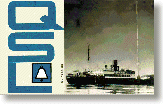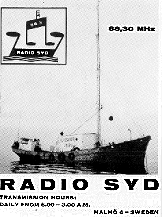
 Sixties City
Sixties City
|
|
 Sixties City Sixties City |
|
|
On April 21st 1960 RADIO VERONICA began test transmissions on 185 metres from a position 3.5 miles off the Dutch coast at Katwijk-aan-Zee. Regular broadcasts began on 6th May 1960 but the Dutch PPT at Nordeich were soon trying to jam their signals so the wavelength was changed, first to 182 metres and shortly after, on May 15th, to 192 metres which it continued to use throughout the Sixties. A survey in November 1960 estimated its audience to be in the region of 5 million listeners. |
|
|
The station was originally owned by two Amsterdam radio dealers whose transmitter was of comparatively low power they were unable to sustain the station commercially. It was taken over by the Verwey brothers from Hilversum who installed a 10kW transmitter enabling the station to be heard throughout the Netherlands, a large part of Belgium and, of course, the east coast of England. Programmes were pre-recorded in studios at Hilversum and transmitted from on board the ship, consisting mainly of pop music with occasional specialist programmes for oldies, jazz and country & western. Only the hourly news, weather bulletins and time signals were broadcast live. During the spring of 1961 the company bought and maintained its own twice weekly supply tender ( Veronica crews changed weekly ) which was a converted fishing boat called 'Ger Anna'. |
|
|
By the end of January 1961 RADIO MERCUR had acquired, on a hire basis, the larger radio ship they were seeking and christened it 'Cheeta II'. It boasted two transmitters after equipment was transferred from the smaller vessel and on January 31st it began broadcasting programmes in both Danish on 88MHz and Swedish on 89.55MHz. They even tried an experiment in stereo broadcasting, using both transmitters simultaneously, which took place on February 7th. |
|
It had been thought that the smaller vessel ( now known as 'Cheeta I' ) might be used as a tender but this proved to be uneconomical so, in July of that year, it was sent to Norway for repairs and a refit as a radio ship again. After several months of technical problems, RADIO NORD finally began making test transmissions on 495 metres from aboard the m.v. 'Bon Jour' ( previously the 'Olga' and soon to be the 'Magda Maria' ) on February 7th. At the time, the vessel was still smack in the middle of Stockholm harbour, which didn't go down too well with the Swedish authorities! A lot of interference was experienced from land-based RADIO LYON transmitting on 498 metres, so the frequency was quickly changed to 602kHz which confused a lot of their listeners. This new ocean-going form of broadcasting prompted the Swedish government to announce on March 2nd that any radio ship transmitting from within Swedish waters would have its equipment confiscated. |
|
On February 16th the first pirate broadcast intended for British audiences could be heard from Hull to Margate transmitted on 192 metres between 5a.m. and 7p.m. from CNBC ( Commercial Neutral Broadcasting Co. ) based aboard the 'Borkum Riff'. The disc jockeys involved were Bob Fletcher, Paul Hollingdale and Doug Stanley but despite their efforts the project was fairly short-lived, being discontinued round about the end of the year in favour of Dutch programmes. Although the Dutch government tried increasingly hard to put them off the air, RADIO VERONICA was to continue broadcasting offshore throughout the Sixties and well into the next decade. |
|
|
September 15th of 1961 saw DCR ( Danmarks Commercielle Radio ) start transmitting programmes on 93.97MHz FM which had been pre-recorded in Copenhagen. The station was based on the radio ship 'Lucky Star' ( originally called 'Nijmah Al Hazz' ) anchored off the coast of Copenhagen and run by ex-staff of RADIO MERCUR who had left after a disagreement regarding profit over programme quality. Despite their ideals, their own content - a mixture of light and more serious music and plays - proved to be unpopular with their target audience. DCR were one of the first pirate stations to transmit 5 minute news bulletins ( at 7a.m. and 7p.m. ) beginning in January 1962. The RADIO MERCUR ship 'Cheeta I' completed her refit and moved to a position off Zeeland on November 25th where she recommenced broadcasting on 89.58MHz. Very shortly afterwards her aerial mast collapsed following which she exchanged places with 'Cheeta II', anchoring off the coast of Copenhagen. DCR merged with its rival, RADIO MERCUR, on January 29th 1962. As the result of a fierce gale on February 12th the 'Cheeta I' had to be towed into Copenhagen and was immediately confiscated and impounded by the Danish police. |
|
|
She was subsequently sold off by Nils-Eric
Svensson to Mrs Britt Wadner |
|
On March 29th the Scandinavian governments all agreed to introduce measures against offshore broadcasters which were due to come into force at midnight on July 31st of that year. This law proved to be the end for RADIO NORD which closed down on June 30th but the 'Magda Maria' was a long way from being finished with the pop pirates. RADIO MERCUR shut down the 'Cheeta II' operation on July 10th and she was taken to Elensburge in Germany where the owners sold her to Britt Wadner, subsequently rejoining 'Cheeta I' to broadcast as RADIO SYD. The 'Lucky Star' continued broadcasting until the end, finally shutting down at five minutes to midnight on July 31st. Nothing more was heard until 5p.m. on August 13th when the 'Lucky Star' recommenced transmissions using old RADIO MERCUR programme recordings. The ex-manager of the defunct station denied any knowledge of the broadcasts claiming he had only used the ship on a hire basis and that it had been repossessed by its owners. On August 16th armed units of Danish police boarded 'Lucky Star' and impounded the unregistered ship until ownership could be established and legal proceedings begun. It is unknown whether any ownership of the vessel was ever claimed. |
 |
|
A little-known project called THE VOICE OF SLOUGH, supposedly based on board a 65ft former fishing vessel 'The Ellen' and equipped with three 1kW transmitters, was believed to be planning to leave its Scottish base in late August for an anchorage off the Nore in the Thames Estuary. The music trade papers at the turn of the year carried articles about another proposed station called RADIO GBLN, also known as RADIO GBOK, which would tape programmes in Dublin and transmit them from a fishing vessel in the Thames Estuary utilising a 5kW transmitter with a range of about 100 miles. Both these projects were initiated by Canadian businessman John Thompson, the latter one with his countryman Arnold Swanson. Neither project materialised because of withdrawals of funding mainly due to drawn-out inconclusive negotiations with the British Phonographic Industry regarding taping of the material. This was a mistake that the later pirates did not repeat - they didn't bother with any sort of negotiations until they were already happily broadcasting the sounds from the safety of international waters. |
|
During late 1962 a pirate station called RADIO ANTWERPEN had been broadcasting Flemish programmes from the ship 'Uilenspiegel' off the coast of Belgium. On December 16th she went aground at Cadzand on the Dutch coast after breaking her anchor chain only a matter of days after Belgian anti-pirate legislation was introduced banning offshore stations. The remains of the gradually sinking ship were blown up in 1971 as they were considered to be a shipping hazard. |
|
|
A consortium called Project Atlanta had contracted to buy the RADIO NORD ship 'Magda Maria' complete after the forced closure of the station and she was moved to El Ferrol on the north-west tip of Spain for refitting. Atlanta was headed by Australian businessman Allan Crawford who had been the managing director of the American company Southern Music between 1955 and 1959. By the early Sixties he had formed his own independent music company, Merit Music, and was using Project Atlanta as a way to promote his record labels in the European market. |
|
|
The 'Magda Maria', now renamed the 'Mi Amigo', left Spain on September 14th 1962 giving her destination as Dover but apparently ended up in the Thames Estuary. It is possible that some tests were made as a station identifying itself as RADIO LN was heard about this time on 306 metres. The project was stalled, however, due to the events surrounding the closure of RADIO MERCUR which scared off the financial backers and the ship was forced to sail to Ostende. She was reported as being at Flushing between January 11th and 15th before setting sail again, then had to stop at Brest for repairs to damaged steering gear on the 19th which took a week. |
|
On January 26th 1963 the 'Mi Amigo'
left Brest heading for the southern coast of the United States where
her American owners planned to turn her into a luxury yacht at Galveston,
Texas. |
|
|